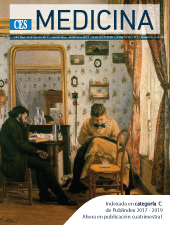Inmunología de la leptospirosis
DOI:
https://doi.org/10.21615/cesmedicina.33.3.4Resumen
Leptospirosis es una enfermedad re-emergente de distribución mundial ocasionada por espiroquetas patogénicas del género Leptospira que afectan humanos, animales domésticos o silvestres. Las manifestaciones clínicas de la enfermedad son diversas y son el resultado de la interacción de la respuesta inmune del hospedador y las condiciones de virulencia propias de las especies patógenas. Aunque se desconocen muchos aspectos de la inmunidad en la infección por Leptospira spp, es reconocido que los hospederos susceptibles presentan diferencias en su respuesta inmune, como la activación/evasión del sistema del complemento, la activación de subpoblaciones celulares, la producción de citoquina y el desarrollo de anticuerpos. El estudio del perfil inmunológico en pacientes con leptospirosis ha sido documentado y contribuye en la identificación de biomarcadores asociados con severidad. Esta revisión presenta algunos de los eventos relacionados con la respuesta inmune desde el ingreso de la bacteria en la fase inicial de la infección hasta su multiplicación y generación de enfermedad en el humano.Descargas
Referencias bibliográficas
2. Haake DA, Levett PN. Leptospirosis in humans. Curr Top Microbiol Immunol. 2015;387:65-97.
3. Seguro AC, Andrade L. Pathophysiology of leptospirosis. Shock Augusta Ga. 2013;39 Suppl 1:17-23.
4. Scharrig E, Carestia A, Ferrer MF, Cédola M, Pretre G, Drut R, et al. Neutrophil extracellular traps are involved in the innate immune response to infection with Leptospira. PLoS Negl Trop Dis. 2015;9(7):e0003927.
5. Cagliero J, Villanueva SYAM, Matsui M. Leptospirosis pathophysiology: into the storm of cytokines. Front Cell Infect Microbiol. 2018;8:204.
6. Reis EAG, Hagan JE, Ribeiro GS, Teixeira-Carvalho A, Martins-Filho OA, Montgomery RR, et al. Cytokine response signatures in disease progression and development of severe clinical outcomes for Leptospirosis. PLoS Negl Trop Dis. 2013;7(9):e2457.
7. Kyriakidis I, Samara P, Papa A. Serum TNF-α, sTNFR1, IL-6, IL-8 and IL-10 levels in Weil’s syndrome. Cytokine. 2011;54(2):117-20.
8. Fraga TR, Isaac L, Barbosa AS. Complement evasion by pathogenic Leptospira. Front Immunol. 2016;7:623.
9. Heinen S, Hartmann A, Lauer N, Wiehl U, Dahse H-M, Schirmer S, et al. Factor H-related protein 1 (CFHR-1) inhibits complement C5 convertase activity and terminal complex formation. Blood. 2009;114(12):2439-47.
10. Fraga TR, Courrol DDS, Castiblanco-Valencia MM, Hirata IY, Vasconcellos SA, Juliano L, et al. Immune evasion by pathogenic Leptospira strains: the secretion of proteases that directly cleave complement proteins. J Infect Dis.
2014;209(6):876-86.
11. Cédola M, Chiani Y, Pretre G, Alberdi L, Vanasco B, Gómez RM. Association of Toll-like receptor 2 Arg753Gln and Toll-like receptor 1 Ile602Ser single-nucleotide polymorphisms with leptospirosis in an Argentine population. Acta Trop.
2015;146:73-80.
12. Du P, Li S-J, Ojcius DM, Li K-X, Hu W-L, Lin X, et al. A novel Fas-binding outer membrane protein and lipopolysaccharide of Leptospira interrogans induce macrophage apoptosis through the Fas/FasL-caspase-8/-3 pathway. Emerg Microbes Infect. 2018;7(1):135.
13. Hu W-L, Dong H-Y, Li Y, Ojcius DM, Li S-J, Yan J. Bid-Induced Release of AIF/EndoG from mitochondria causes apoptosis of macrophages during infection with Leptospira interrogans. Front Cell Infect Microbiol. 2017;7:471.
14. Hu W, Ge Y, Ojcius DM, Sun D, Dong H, Yang XF, et al. p53 signalling controls cell cycle arrest and caspase-independent apoptosis in macrophages infected with pathogenic Leptospira species. Cell Microbiol. 2013;15(10):1642-59.
15. Garcia LE, de Araújo Junior EC, Melo LM, Bragato JP, Peiró JR, Félix de Lima VM, et al. Characterization of the microtranscriptome of macrophages infected with virulent, attenuated and saprophyte strains of Leptospira spp. PLoS Negl Trop Dis. 2018;12(7):e0006621.
16. Silva PL da, Lauretti-Ferreira F, Caldas de Lima M, Lima SS, Covarrubias AE, De Franco M, et al. Phagocytosis of Leptospira by leukocytes from mice with different susceptibility to Leptospirosis and possible role of chemokines. BMC Microbiol. 2019;19(1):4.
17. Gaudart N, Ekpo P, Pattanapanyasat K, van Kooyk Y, Engering A. Leptospira interrogans is recognized through DC-SIGN and induces maturation and cytokine production by human dendritic cells. FEMS Immunol Med Microbiol. 2008;53(3):359-67.
18. Pezzolato M, Maina E, Lonardi S, Bozzetta E, Grassi F, Scanziani E, et al. Development of tertiary lymphoid structures in the kidneys of pigs with chronic leptospiral nephritis. Vet Immunol Immunopathol. 2012;145(1-2):546-50.
19. Volz MS, Moos V, Allers K, Luge E, Mayer-Scholl A, Nöckler K, et al. Specific CD4+ T-Cell reactivity and cytokine release in different clinical presentations of Leptospirosis. Clin Vaccine Immunol CVI. 2015;22(12):1276-84.
20. Alia SN, Joseph N, Philip N, Azhari NN, Garba B, Masri SN, et al. Diagnostic accuracy of rapid diagnostic tests for the early detection of Leptospirosis. J Infect Public Health. 2018.
21. Rubbo P-A, Soupé-Gilbert M-E, Golongba DM, Mbombo F, Girault D, Nakouné E, et al. Evidence of human Leptospirosis cases in a cohort of febrile patients in Bangui, Central African Republic: a retrospective study, 2012-2015. BMC Infect
Dis. 2018;18(1):376.
22. Ramli SR, Moreira GMSG, Zantow J, Goris MGA, Nguyen VK, Novoselova N, et al. Discovery of Leptospira spp. seroreactive peptides using ORFeome phage display. PLoS Negl Trop Dis. 2019;13(1):e0007131.
23. Silveira MM, Oliveira TL, Schuch RA, McBride AJA, Dellagostin OA, Hartwig DD. DNA vaccines against Leptospirosis: A literature review. Vaccine. 2017;35(42):5559-67.
24. Lin X, Xiao G, Luo D, Kong L, Chen X, Sun D, et al. Chimeric epitope vaccine against Leptospira interrogans infection and induced specific immunity in guinea pigs. BMC Microbiol. 2016;16(1):241.
25. Koizumi N, Muto MM, Izumiya H, Suzuki M, Ohnishi M. Multiple-locus variable- number tandem repeat analysis and clinical characterization of Leptospira interrogans canine isolates. J Med Microbiol;64(Pt 3):288-94.
26. Ghazali-Bina M, Reza Pourmand M, Mirshafiey A, Bakhtiari R, Khaledi A, Kazemian H et al. Vaccine potential of LenA and LcpA proteins of Leptospira interrogans in combination with Escherichia coli heat-labile enterotoxin, B subunit (LTB). -
PubMed - NCBI [Internet]. [citado 24 de mayo de 2019]. Disponible en: https://
www.ncbi.nlm.nih.gov/pubmed/30996830
Descargas
Publicado
Cómo citar
Número
Sección
Licencia

Esta obra está bajo una licencia internacional Creative Commons Atribución-NoComercial-CompartirIgual 4.0.
Derechos de reproducción (copyright)
Cada manuscrito se acompañará de una declaración en la que se especifique que los materiales son inéditos, que no han sido publicados anteriormente en formato impreso o electrónico y que no se presentarán a ningún otro medio antes de conocer la decisión de la revista. En todo caso, cualquier publicación anterior, sea en forma impresa o electrónica, deberá darse a conocer a la redacción por escrito.
Plagios, duplicaciones totales o parciales, traduccones del original a otro idioma son de responsabilidad exclusiva de los autores el envío.
Los autores adjuntarán una declaración firmada indicando que, si el manuscrito se acepta para su publicación, los derechos de reproducción son propiedad exclusiva de la Revista CES Medicina.
Se solicita a los autores que proporcionen la información completa acerca de cualquier beca o subvención recibida de una entidad comercial u otro grupo con intereses privados, u otro organismo, para costear parcial o totalmente el trabajo en que se basa el artículo.
Los autores tienen la responsabilidad de obtener los permisos necesarios para reproducir cualquier material protegido por derechos de reproducción. El manuscrito se acompañará de la carta original que otorgue ese permiso y en ella debe especificarse con exactitud el número del cuadro o figura o el texto exacto que se citará y cómo se usará, así como la referencia bibliográfica completa.
| Estadísticas de artículo | |
|---|---|
| Vistas de resúmenes | |
| Vistas de PDF | |
| Descargas de PDF | |
| Vistas de HTML | |
| Otras vistas | |



